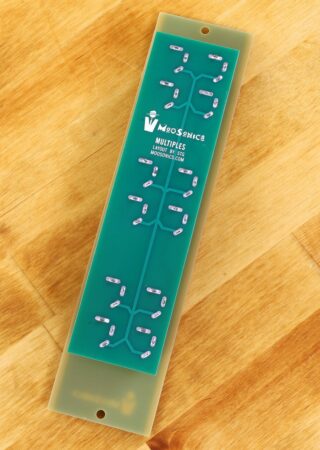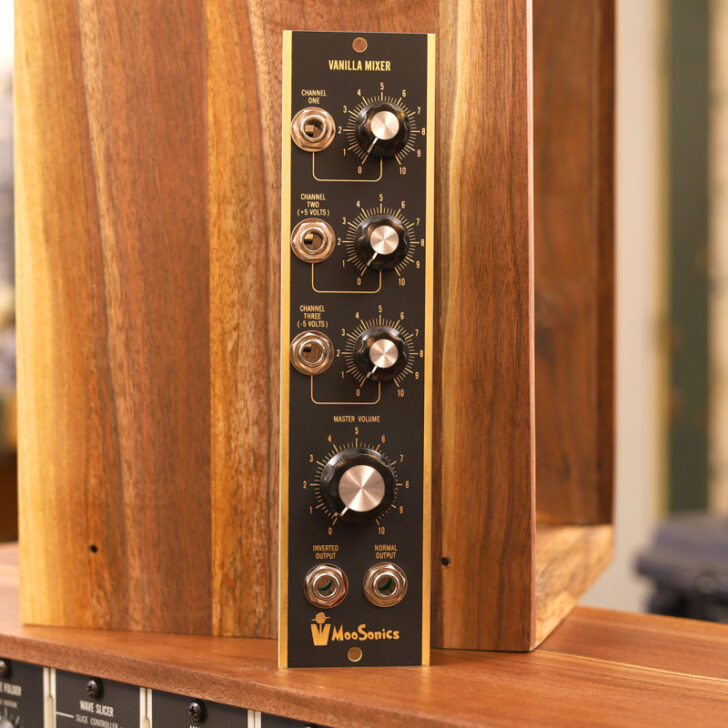STG Soundlabs head honcho and Knobcon founder Suit & Tie Guy has launched a new synth module line, MooSonics, that promises to make Moog-format modules affordable.
One of the key appeals of the Eurorack format has always been its affordability, compared to the larger Moog format. MooSonics challenges that, with Moog-format modules starting at $75 for full DIY module kits.
The name ‘MooSonics’ is a play on ‘muSonics’, the company that bought out the original Moog in the early 1970’s. STG has also previewed an upcoming muSonics line, which promises to offer modern interpretations of classic Moog format modules.
Just as ‘MooSonics’ is a playful take on ‘muSonics’, Suit & Tie Guy is getting creative with the design of the MooSonics line, in order to make it more affordable. A key difference is that the panels are flat and made of printed PCB material. Front panels are the most expensive component of many module designs, so this, and the kit approach, go a long way towards making these modules affordable.
We purchased and assembled MooSonics’ first two module designs – Attenuators and Multiples. They’re both easy DIY projects.
Once installed in a MU system, the panels look and perform comparably to modules from other manufacturers:

The MooSonics modules use modern PCB design, so the assembled modules are only about 1 inch deep.
Suit and Tie Guy hasn’t shared specs for the line – it may be too early in the process – but it looks like the modules will be very ‘skiff-friendly’, compared to traditional Moog designs and Synthesizers.com designs.
The MooSonics line currently features three modules:
- Attenuators consists of three passive circuits that can be used to reduce the amplitude of any audio or control signal. The signal input to the top attenuator is chained to the bottom two in series. Introduction of a phone plug into middle or bottom input breaks the normalling system: 1 to 1-2-3, 1-2 to 2-3, 1-2-3 to 1-2-3.
- Multiples consists of three sets of four phone jacks. The top left input of the bottom two groups of jacks is normalled to the tips of the group above it, so you can send one signal to a maximum of 9 destinations from this panel.
- The Vanilla Mixer is based on the output mixer of “a certain American two voice synthesizer from the 1970s. If you need a second hint, think of vanilla ice cream.” Suit has added a third channel, an inverted output, and normalised DC offsets, to allow for a variety of voltage processing and tone shaping operations. The DIY build is very flexible, because you can choose which op amps, gain staging, and ac/dc coupling options, to make two completely different mixers. These options are documented on the PCB itself.
The kits should be easy projects for experienced builders, but MooSonics currently does not provide build documentation. PCBs are labeled with all component values and build options, which is all that many experienced DIYers will need.
“There is an assumption that buyers have some experience in building electronic devices,” they note. “If you have no experience, this would be a great place to start, but you will need to do some research on basic assembly techniques.”
Suit and Tie Guy plans to eventually offer all the modules needed to create a complete MooSonics system. Once this is done, he hopes to hold weekend build workshops, where you could build a complete modular system.
Pricing and Availability:
MooSonics modules are now available in limited quantities, with prices starting at $75 for the kits and $95 for assembled modules.




not bad at all. nice work. full size pots a plus!
I’m haven’t been into modular synths since I sold my Polyfusion around 1978. Most of the Eurorack stuff completely escapes me. Does this bring anything that is really new to the table that Behringer hasn’t already produced?
Behringer hasn’t bought anything new to the table. Seriously, where would you get that idea?
OK. I thought that Behringer has a whole line of Eurorack modules, and since they nailed both the original Minimoog oscillators and ladder filter so well in the Model D, some of those may be Moog clones. As I stated I don’t follow modular stuff (especially by Part #) anymore, and I was just asking a question. But, that’s where I got THAT idea.
John
You’re right that Behringer has released a whole bunch of Euro modules. Their line is mostly knockoffs of stuff from the ’70s. So nothing really new there – just smaller & cheaper copies.
They have three or four modules that are copies of newer things – a clone of the Mutable Instruments Plaits, and a couple of oscillators based on popular ’80s synths.
The Behringer stuff mainly appeals to people just starting out and to people that are nostalgic for big ’70s modulars that don’t want to pay for a big ’70s modular.
When it comes to new stuff in Eurorack, companies like Mutable Instruments, Noise Engineering, Tiptop Audio, Make Noise, Rossum, Intellijel, Moog, Doepfer and others are doing original stuff that’s a lot more interesting and useful.
Nothing new but modules affordable enough that most anyone can now get into modular areas that were only reserved for rich collectors.
The ‘rich collectors’ line is BS made up by companies like Behringer.
Musicians have been buying modular synths for 50 years, even when they were super-expensive.
Eurorack has been affordable for decades, though. Doepfer has hundreds of modules and most of them are around $100 to $150.
Behringer’s only “innovation” is selling knockoff modules. They’re not really cheaper or better than other modules, they just look like something that’s more expensive, tricking simpleminded people into thinking that they’re getting a bargain.
For example, Doepfer sells modules based on all the classic filter designs, all priced around to $100. They’ve been doing this for 20 years. Behringer charges $110 for their Moog filter design, but they package it as a Moog knockoff, so suckers that don’t know Eurorack think that they are getting a bargain.
Probably paid by Behringer to say, “but Behringer…” in anything they touch. So tired of this honestly.
Except for affordability for those who couldn’t otherwise buy a new synthesizer and the Deepmind 12 and 6 and the Neutron.
Now, where are my Oreo knock-offs?
Euro has been cheap for 20 years. See my comment above.
People that think Behringer has made Euro cheaper are noobs that don’t know any better. Behringer figured out 30 years ago that, if you copy the look of something expensive, people are dumb enough to pay a premium for it.
Behringer currently doesn’t compete in the 5U format. these are cost reduced versions of existing Moog and Moog-like module types. nothing ‘new’ here other than a cost reduction in the front panel – note the ‘full size’ panel potentiometers. whether this method scales up to any additional economy will be interesting. but most of the cost here was in front panel fabrication and minimum lot math.
Thanks! I guess my brain is more scrambled than even I think it is.
Ironically, you’re asking what’s new that’s being brought to the table but haven’t bothered to check eurorack
No, that’s not what I was asking, at all. Since these modules are actually affordable, I was asking if there was anything new in them that wasn’t already covered by Behringer (that is also affordable). It’s true that I probably shouldn’t have asked that here, because now I have two specific replies to my question that appear to be at odds as to whether Behringer makes Eurorack modules, at all? It seems that Behringer makes some kinds of modules, and for the hell of it, I was wondering what it would cost to come close to replicating my Polyfusion rack, today.
This is not eurorack, Behringer, or Polyfusion. This is Moog format and it’s MooSonics. Coincidentally, Polyfusion was started by ex-Moog employees, Behringer has tried to poach ex-Moog employees, and I am an ex-Moog employee (from a certain point of view.)
I guess what I’m doing here is trying to make the best modular format in the world more accessible. Uli Behringer has not done this and will never do this. They have made it clear they are fully committed to eurorack, and quite frankly I think that was the right choice for them.
Also I want to make it clear there will be NO Moog tribute circuits in the MooSonics line. All that stuff is for my premium lines. MooSonics is an opportunity for me to play around with other circuits and designs that just don’t fit in my other brands. There’s a lot of cool stuff I’ve wanted to do in the past that just never made sense and now they do.
Suit – if you see this can you share anything about future plans and timetable?
I’d love to do a wall-mount MU rig (my studio is out of floor space) and this seems like it could be a good way to do it. I’ve seen shallow Euro systems wall mounted, and it seems like a really practical option.
Hey thanks for asking. My goal is to finish the basic synthesiser (envelope/VCA is almost done, VCO and VCF are in process) by the end of January. The LFO/Noise/SH module will come after that, and at that point it’s pretty much a complete synthesiser and I can start thinking about what other functions I want to add to the line. I designed a bunch of sequencing modules already in schematic form but I’m not sure if I can fit them in through-hole in the front panel layouts I want.
I’m not sure when the new power supply will be done, I hired an engineer to design that for me and I’m going to tell him it should be done in January, he’s had enough time. It will be a module itself, so something like this would actually work out great for a wall hanging thing, because you can put the power supply on the front of the cabinet.
Another thing that’s in process is an aluminum extrusion for designing more affordable cabinets. They would be similar to Tip-Top Z-Rails but specifically for Moog format. The aluminum company has reviewed the profile I designed and adjusted it for their process, and sent me a quote for the die and the manufacturing. As soon as I can afford to pay for the die, It will be 2-3 months and then I will have the new rails.
Anyway, I could build you a two inch deep frame that would hold a row or two or whatever of modules. Email me if you’re interested. It sounds like a good product idea and I would give you a good price on it for requesting it. I think it would be pretty lit if we put it in some elaborate gold leaf picture frame.
(caveat: I can only promise MooSonics modules would fit into and certain other modules. Part of my new Moog-format-only focus is making sure everything I make from now on is only one inch or so deep.)
oh very nice idea:) i didn’t think 5U would ever be affordable…. i was expecting a much higher price tag and was pleasantly surprised. i guess printed PCB boards for the panels makes a big diff. good idea:) ? opening up the world of 5U to a new range of people:)